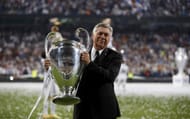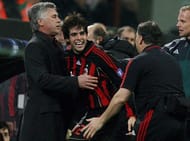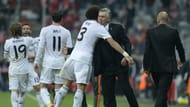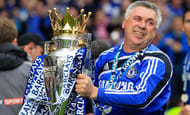“Being a manager is no fun at all. You have to put up with all the hassle. It is not surprising that so many turn grey or have heart attacks.”
While the above quote by the Dutch legend Ruud Gullit might’ve bordered a bit on exaggeration and scepticism, his statement is partly true. For modern football has become such a rat-race that margin for errors are minimal, even non-existent. And in a world as cut-throat as the one we’re talking about, scapegoats and fall guys are imperative – sacking the managers and pinning the blame on them is the easiest thing to do. It does away with the need to conduct a thorough post-mortem, and also promises a quick-fix new dawn.
Succeeding in a profession so difficult is rare. Succeeding consistently requires superhuman effort, intelligence and most importantly, adaptability. We’ve had great managers in the game over the years – Shankly, Paisley, Busby, Sacchi, Cruyff, Strachan, Sir Alex – to name but a few. We have great managers today, some of whom might go on to become one among the pantheon of greats mentioned earlier – Jose Mourinho, Louis Van Gaal, Jurgen Klopp, Pep Guardiola, Diego Simeone, Manuel Pellegrini, Carlo Ancelotti, and many others. But it’s the Italian that I want to talk about here.
Ancelotti is the most flexible in changing his tactics according to his players
That Carlo Ancelotti is a modern-day managerial great is beyond doubt. The accolades and honours he’s won over the years, across different leagues, with different players, are testament to that. But is there anything that stands him apart from his peers? What makes the man from Reggiolo succeed in so many different countries?
Firstly, it is his wonderful ability to change tactics and systems according to the needs and skill-sets of the players available. This is a trait seldom seen in managers today. Let’s look at the managers I talked about earlier. Whether it be at River Plate, San Lorenzo, Catania, Racing or Atletico, Diego Simeone has always prided himself on the fact that his teams are built from the back. Incredibly strong at set-pieces, Simeone’s blueprint for success has always been at the heart of the park – in the centre of midfield.
Jurgen Klopp on the other hand has been a strong advocate of defence being the first line of attack, and vice-versa. His Mainz and Dortmund teams have always played out from the back when they’ve had the ball, and press high up the pitch without it – defending as one single unit. Upon winning the ball back, they unleash devastating counter-attacks.
Then there’s the “Special One”. Jose Mourinho has just one tactic – win at all costs. Whether it involves parking the bus, cynical tackles, unsporting time-wasting or a combination of all three, it doesn’t concern him. All that matters is the end result. Except for his ill-fated stint at Madrid, Mourinho has never been a fan of free-flowing, dynamic football and has been a nightmare coach for playmakers.
Pep Guardiola’s philosophy of the game, meanwhile, is the very antithesis of what Mourinho believes in. Fatally ignoring the defensive aspects of the game at times, Guardiola’s teams have always been technically brilliant, with a lot of dynamism involved. One can safely say that he’s the least adaptable among all the managers we’ve talked about – he is devoutly married to his philosophy of ball retention at all costs.
Manuel Pellegrini and Van Gaal have shown some signs of flexibility, moulding their tactics as per their team, but even they’ve always been fans of football played at a quick tempo, with a lot of off-the-ball movement.
Carlo Ancelotti is the only manager in this list who has truly and totally adapted to the needs and situations of his team, as and when required.
Termed defensive-minded and boring during his stint as AC Milan supremo by his own chief, Silvio Berlusconi, the same man was criticised for not paying enough attention to the defensive aspects of the game by the Marca newspaper early last year when Madrid were struggling with the absence of Xabi Alonso. Ancelotti has never had a fixed tactic or philosophy. He studies his players, analyses their strengths and weaknesses, and ultimately engineers a team in such a manner that he almost always gets the best out of them. Three domestic league titles and an equal number of Champions League titles speak volumes about this ability of his.
He revamped AC Milan and brought their glory days back
Taking charge of a waning AC Milan team that was languishing in the UEFA Cup at the time of his arrival, Ancelotti immediately went about changing the way the team played, assigning new roles to his players and imparting a level of tactical awareness that hadn’t been seen in the team before. One among those changes was his inspired decision to shift a certain Andrea Pirlo from the hole behind the strikers to his Trequartista/Deep-lying playmaker role.
This move benefitted not just Pirlo and Rui Costa – their other No. 10, but the team as a whole – their young Brazilian winger Kaka was moved to the centre, a position from which he dominated Italian and world football for years to come. Similarities between the shifting of Kaka from the wings to midfield and that of Di Maria in Madrid last season are hard to ignore.
It was with that Milan team, chopped and changed precisely according to the needs of the hour, that Ancelotti won his maiden Champions League trophy – beating his old paymasters and bitter rivals, Juventus, in the finals. Sweet revenge, indeed.
The following season, the Rossoneri took home the Scudetto, winning the League title after a considerable gap. Considered a good cup manager and a bad league manager, it is actually a tribute to Ancelotti and the achievements expected of him, that people call a manager with three league titles, a bad one.
It was at the San Siro that he first showed signs of his exceptional man-management skills as well. Re-uniting and giving new impetus to a team that was breaking at the seams, Ancelotti managed to coax the best out of his team, a catalogue of stars – Dida, Cafu, Stam, Serginho, Seedorf, Crespo, Shevchenko, Gattuso, Pirlo, Maldini, Nesta, Rui Costa, Kaka, Inzaghi.
Experienced managers always acknowledge that a team with a lot of stars, and conversely, a lot of egos, is very hard to manage. Issues that happened between Balotelli and Roberto Mancini, or Ibrahimovic and Guardiola, are cases in point. Even Sir Alex lost it and left David Beckham with a few stitches. But Ancelotti, in spite of having managed a galaxy of stars at Turin, Milan, London, Paris and Madrid, has never had any issue with his players.
Going back to the 2013-14 season, when he arrived at the Bernabeu, the situation at Madrid was worse than what he had to deal with at Milan. The team was in a shambles after having fallen at the penultimate hurdle of their La Decima dream for a third successive time. Moreover, Mourinho had left the team with a bad taste in their mouths – puncturing the team spirit, and creating divisions in the squad. Having alienated senior members of the squad like Pepe and Iker Casillas, Mourinho had left his successor with the unenviable task of picking up the remains of a troubled season and starting from scratch.
Ancelotti not only oversaw a rebuilding of the team in certain ways, he oversaw a massively successful one, as the Los Blancos went on to win the Cup double – winning the Copa Del Rey, and more importantly, La Decima. The magnitude of what the Italian had achieved in his very first season can be gauged from the failures of his famed predecessors to do so – Carlos Queiroz, Jose Antonio Camacho, Mariano Garcia Remon, Vanderlei Luxemburgo, Juan Ramon Lopez, Fabio Capello, Bernd Schuster, Juande Ramos, Manuel Pellegrini and Jose Mourinho, all swinging and missing. Let’s take a closer look at the historic campaign.
Real Madrid – 2013/14
Jose Mourinho’s Madrid played and adhered strictly to a defensive 4-2-3-1 formation at all times, with Arbeloa staying back, while Marcelo/Coentrao assisted Ronaldo on the left flank. Every time Marcelo bombed forward, it was left to the midfield axis of Khedira-Alonso to fall back and pick up the pieces. With Mesut Ozil playing the No10 role behind Karim Benzema/Gonzalo Higuain, and Ronaldo-Di Maria flanking them on either side, the team was devastating on the counter, but lacked fluidity while moving forward, at times.
Ancelotti had to rectify this failing by addressing to their movement going forward, without compromising on their defensive solidity. While the departure of Ozil hamstrung his plans early on as a direct aftermath of Gareth Bale’s signing, it was the ensuing vacancies in midfield and how he solved them, that really shows how good a manager he is. By playing the crafty, yet industrious Di Maria in the centre, he could accommodate Bale in the right, as well as compensate for the loss of Ozil.
Di Maria ensured that there would be less workload on the two deep lying midfielders, unlike in 2012-13, where Ozil’s defensive contributions were minimal. This enabled the manager to pick a more creative third central midfielder in Luka Modric, thus giving his team some much-needed fluidity. The new 4-3-3 that he employed at the Bernabeu was complete in all senses, as Dani Carvajal replaced Arbeloa, thus giving more emphasis for attacks through the right flank too, ably supporting Gareth Bale.
Castilla graduates given more first team chances
Not only did he iron out the flaws within the team tactically, he rectified them within the dressing room too. A prime example of this was playing Iker Casillas in the cup competitions and playing Diego Lopez in La Liga. Also, he managed to keep the youngsters motivated at all times, and minimised the lack of frustration that a Castilla graduate or any young Madrid player is bound to undergo, given Florentino Perez’s flawed Galactico policy (more on that later).
The likes of Alvaro Morata, Jese Rodriguez and Casemiro were all given game-time during some of the biggest matches of the season, with Jese coming to the fore until he was struck by the scourge of wingers – the anterior cruciate ligament tear. All this, along with the fact that he was able to bring out the very best in both Ronaldo and Bale, resulted in a phenomenally successful debut season for Ancelotti, in spite of his hand being forced by some questionable decisions from the board.
The fundamentally flawed footballing logic of Florentino Perez has been well documented. Right from the first Galactico Era, when he sold Claude Makelele, to a month and a half ago, when he sold Di Maria and Xabi Alonso, he has been a pain in the neck for all managers concerned. And with the current season and its transfer window being more inflated by the hype of the World Cup, Ancelotti has had to suffer the brunt of Perez’s self-destructive methods.
Less tolerant managers would’ve walked away – Tony Pulis did it with Crystal Palace; Antonio Conte did it with Juve.
But with a severely imbalanced squad, rich in attack and poor in defensive midfield, Ancelotti still managed to find solutions, the team rolling faster than an Australian juggernaut in spite of suffering a few early hiccups. This is no easy task – look at how hard Louis Van Gaal is finding things at Old Trafford, with a top heavy squad. Granted, Madrid have an infinitely better defensive line-up, but managers of other clubs do not have to deal with owners breathing down their necks, or even having a say on the starting XI.
A modern day managing great
Unfortunately, eccentric owners and Ancelotti seem to share a magnetic relationship. He had to listen to Berlusconi criticising him at Milan immediately after winning the biggest title in club football. He had to contend with Roman Abramovich – the less said about him, the better. Known for a manager-turnover rate that would put even Daniel Levy to shame, Abramovich appointed Ancelotti as the fourth manager in post-Mourinho Chelsea in 21 months.
Not only did Ancelotti win the league title at the Bridge, he also managed to win the FA Cup, attaining the first League-Cup double in the history of the West London club. But he was sacked in typical Abramovich style on the final day of the next season as Chelsea finished behind United.
For Ancelotti, it was bitter déjà vu, as a previous experience of an undeserved sacking, at the hands of Juventus (he had just won the Intertoto Cup with them), had left him unemployed, until Milan came calling.
He achieved the same result in his only full season at Paris, as PSG comfortably romped home to the league title. Immediately after that he resigned as manager to take up the Madrid job, a decision that was more than vindicated in 12 months’ time.
The countless continental, domestic and individual honours all point to one of the legends of football management; and while Carlo Ancelotti is never given his due when compared to other celebrity managers, he’s equally deserving of it, if not more. His ability to switch tactics and philosophies appropriately, his faith and trust which endear him to his players, and his willingness to work within the confines, limitations and inadequacies of his employers, all make him a manager like no other.
After having suffered an incredibly heartbreaking defeat against Liverpool in the Champions League final on that historic night at Istanbul, Ancelotti set about tweaking the structure of his team, and regenerating confidence in a few shattered men. Two years later, they would go on to beat the same opponents on the same stage.
When faced with adversity, Ancelotti didn’t quit, he didn’t give up. He simply did what he does best – he adapted. Truly, he is a modern day managing great.




